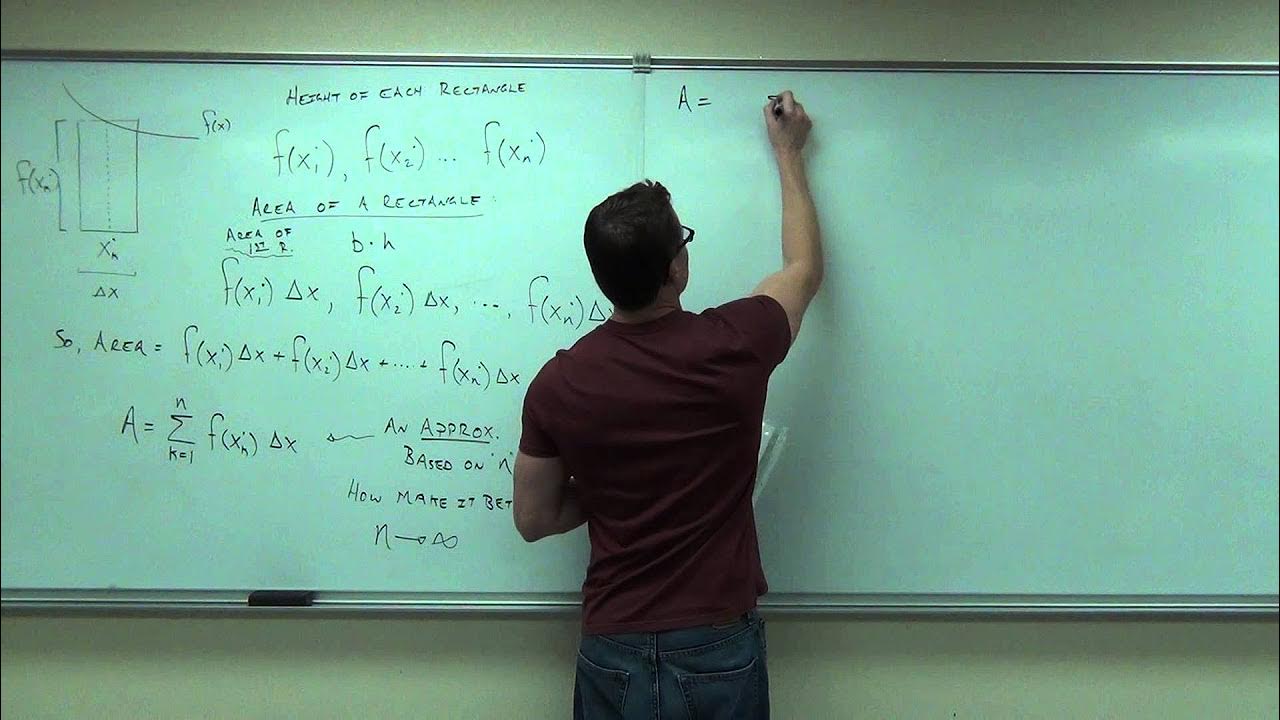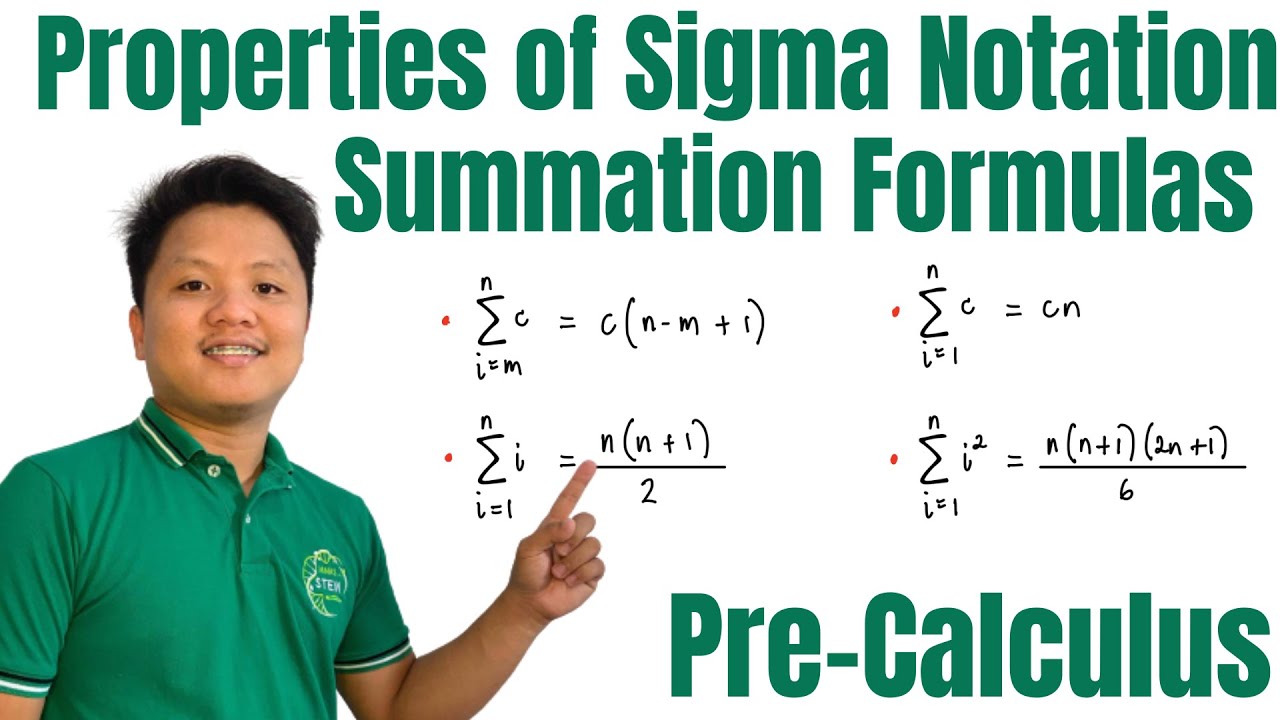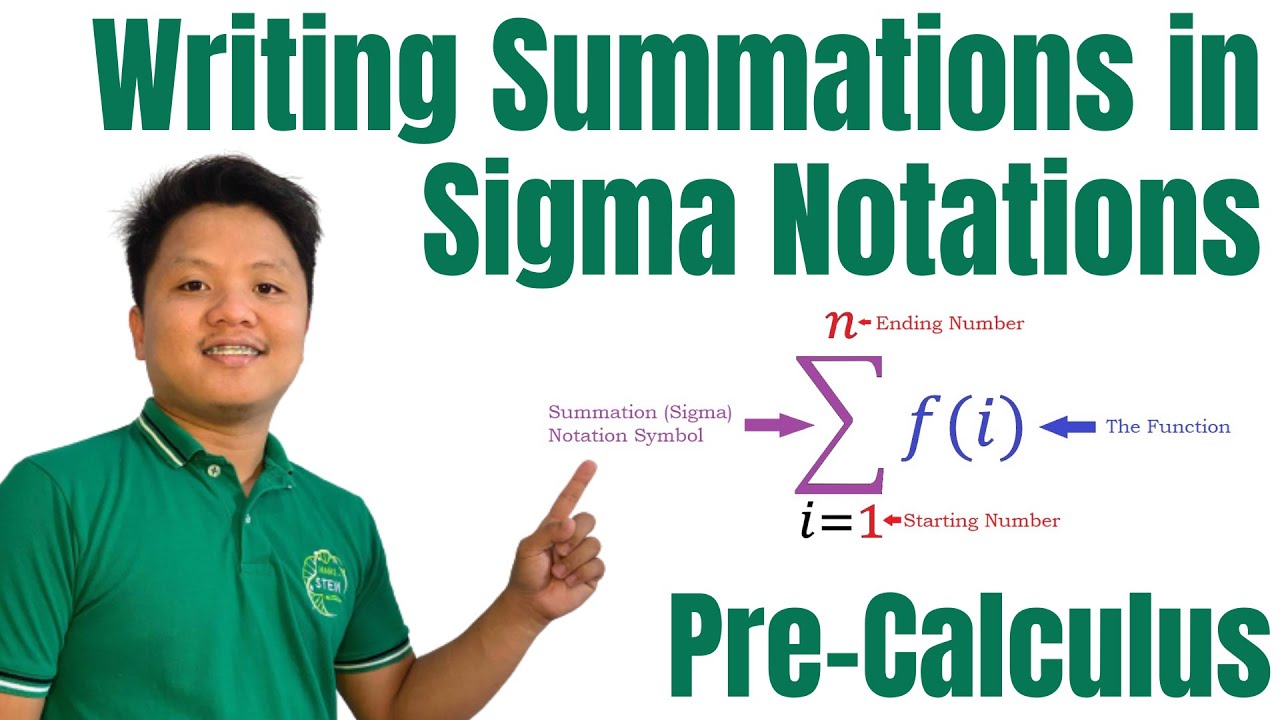Summation Formulas and Sigma Notation - Calculus
TLDRThe video script provides a comprehensive guide to summation formulas in calculus, essential for calculating areas of regions. It explains how to evaluate sums using sigma notation with both constants and variables, and covers various examples, including arithmetic sequences. The script also introduces formulas for summing powers of 'i', such as i squared and i cubed, and demonstrates their application through step-by-step problem-solving. The aim is to help viewers understand and practice these fundamental calculus concepts to solve summation problems efficiently.
Takeaways
- 📚 Summation notation (Σ) is used to represent the addition of a sequence of terms.
- 🔢 For a constant 'c' and 'i' starting at 1 up to 'n', the sum is c * n.
- 🌟 The formula for the sum of the first 'n' natural numbers is n * (n + 1) / 2.
- 📈 When the variable 'i' is involved, the sum can be expressed as n * (n + 1) / 2 for the sum of i from 1 to n.
- 🔍 Example: If summing the variable i from 1 to 5, the result is 15, confirmed by the formula 5 * (5 + 1) / 2.
- 📝 For a sequence like 6*i, the sum from i=1 to i=4 is 60, calculated by 6 * (4 * (4 + 1) / 2).
- 🚀 The sum of an arithmetic sequence like 7i - 3 from i=1 to i=5 is 90, using the formula 7 * (5 * (5 - 1 + 1)) / 2 - 3 * 5.
- ✨ The formula for the sum of squares of the first 'n' natural numbers is n * (n + 1) * (2n + 1) / 6.
- 🌠 The formula for the sum of cubes of the first 'n' natural numbers is (n * (n + 1) / 2)^2.
- 🔑 For a混合 sequence like i*i^2 + 4i, the sum from i=1 to i=5 is 445, calculated by separating the terms and applying the appropriate formulas.
- 🎯 When dealing with a sequence like (i - 1)^2, the sum from i=1 to i=9 is 204, achieved by applying the sum of squares formula and adjusting for the sequence's specifics.
Q & A
What is the summation notation used in calculus to represent the addition of a series?
-The summation notation, often denoted by the sigma symbol (Σ), is a mathematical notation used to represent the sum of a series. It is typically used in calculus to find the total of a sequence of numbers or functions.
How do you evaluate a sum given in sigma notation with a constant?
-To evaluate a sum with a constant in sigma notation, you multiply the constant by the number of terms in the series. For example, if the sum is represented as 8Σ from i=1 to n, and n is 4, then the sum is 8 times 4, which equals 32.
What is the formula for the sum of the first n natural numbers?
-The formula for the sum of the first n natural numbers is given by n * (n + 1) / 2. This formula allows you to find the sum of all integers from 1 to n.
How can you use the formula for the sum of the first n natural numbers to solve a problem?
-You can use the formula by substituting the given value of n into the formula and calculating the result. For instance, if you need to find the sum of numbers from 1 to 5, you would substitute 5 for n and get 5 * (5 + 1) / 2 = 15.
What is the summation formula for the sum of the squares of the first n natural numbers?
-The summation formula for the sum of the squares of the first n natural numbers is given by n * (n + 1) * (2n + 1) / 6. This formula allows you to find the sum of the squares of all integers from 1 to n.
How do you evaluate a sum with a variable i in sigma notation?
-To evaluate a sum with a variable i in sigma notation, you first determine the pattern or rule that the variable i follows, and then apply the appropriate summation formula. For example, if the sum is represented as Σ(i^2) from i=1 to n, you would use the formula for the sum of squares.
What is the formula for the sum of the cubes of the first n natural numbers?
-The formula for the sum of the cubes of the first n natural numbers is given by (n^2) * (n + 1)^2 / 4. This formula enables you to find the sum of the cubes of all integers from 1 to n.
How can you simplify a summation problem with both a variable and a constant?
-You can simplify such a problem by distributing the constant to each term in the series and then separating the sum into parts. Each part can then be evaluated using the appropriate summation formula.
What is the summation formula for the series i(i^2)?
-The summation formula for the series i(i^2) is the sum of the cubes of the first n natural numbers, which is (n^2) * (n + 1)^2 / 4.
How do you confirm the answer to a summation problem using a formula?
-To confirm the answer, you can first calculate the sum using simple addition or the given formula, and then compare the result with the answer obtained from the problem. If both answers match, it confirms that the formula was applied correctly.
What is the process for evaluating a summation problem with a mixed expression like i - 1 squared?
-First, you expand the mixed expression using the distributive property (FOIL method). Then, separate the expanded expression into individual summations, each following a specific pattern. Apply the appropriate summation formula to each part and combine the results to get the final answer.
How do you handle a summation problem with a sequence that is not arithmetic?
-For non-arithmetic sequences, you may need to first identify the pattern or rule governing the sequence. Once identified, you can apply the appropriate summation formula or method to find the sum. In some cases, a direct summation may be necessary.
Outlines
📚 Summation Formulas in Calculus
This paragraph introduces the concept of summation formulas in calculus, which are essential for calculating the area of a region. It explains the basic formula for a constant summation, represented by the sigma notation, where 'c' is the constant and 'n' is the number of terms. The formula is c * n, demonstrated with an example of adding 8 fours, resulting in 32. Further examples are provided to solidify the understanding of evaluating a sum with a constant in sigma notation. The paragraph then transitions to discussing a more complex formula involving the variable 'i' instead of a constant, which is calculated as n * (n + 1) / 2. This is illustrated with an example that sums numbers from 1 to 5, confirming the result with the formula. The paragraph concludes with additional examples to practice evaluating sums using different formulas.
🔢 Arithmetic Sequences and Summation
The second paragraph delves into arithmetic sequences and their summation. It begins with an example of 7i - 3, where 'i' starts from 1 and goes up to 5, creating an arithmetic sequence with a common difference of 7. The sum of this sequence is calculated both manually and using the summation formulas. The paragraph then introduces the concept of separating the summation into two parts: one for the arithmetic sequence (n * (n - 1) / 2) and one for the constant (c * n). The results from both methods are compared to confirm the accuracy of the summation formulas. The paragraph concludes with a practice example of 9i + 7, where 'i' goes from 1 to 5, and the summation is calculated using the appropriate formulas, leading to the final answer of 380.
📈 Powers of 'i' and Their Summation
This paragraph focuses on summing powers of 'i', starting with 'i squared'. The formula for summing squares of numbers up to 'n' is given as n * (n + 1) * (2n + 1) / 6, and this is confirmed with an example that sums squares from 1 to 6. The paragraph then moves on to 'i to the third power', with the formula n^2 * (n + 1)^2 / 4, and an example is provided for 'n' equal to 4. The concept is further expanded with a practice example of i * (i squared + 4i), where 'i' goes from 1 to 5. This involves distributing 'i' and separating the expression into two summations, one for 'i to the third power' and another for 'i squared', both calculated using their respective formulas.
🧩 Advanced Summation Techniques
The final paragraph explores advanced summation techniques, starting with the example of i - 1 squared from 1 to 9. This involves factoring and combining like terms to rewrite the expression as i squared - 2i + 1, which is then separated into three summations. The appropriate formulas for each part are applied, considering 'n' as 9 for this problem. The paragraph demonstrates the step-by-step calculation using the formulas, leading to the final answer. The detailed explanation and breakdown of the process highlight the efficiency of using summation formulas in solving complex problems involving sequences and series.
Mindmap
Keywords
💡Summation Formulas
💡Sigma Notation
💡Arithmetic Sequence
💡Area of a Region
💡Constant
💡Variable
💡Practice Problems
💡Quadratic Terms
💡Cubic Terms
💡Foil Method
💡Distributed
Highlights
The video discusses summation formulas in calculus, which are crucial for finding the area of a region.
Sigma notation is used to represent the summation of a series.
For a constant 'c' and 'i' starting at 1 up to 'n', the sum equals 'c' times 'n'.
The example of summing the constant 8, four times, results in 32 using the formula.
The formula for the sum of a variable 'i' from 1 to 'n' is 'n' times 'n' plus 1, divided by 2.
The sum of the numbers from 1 to 5 is demonstrated both through calculation and the formula, resulting in 15.
The summation of '6 times i' from 1 to 4 is calculated to be 60, confirmed using the formula.
The video shows the evaluation of the sum '7i - 3' from 1 to 5, resulting in 90.
The summation formula for '9i + 7' from 1 to 5 is used to arrive at the answer 380.
The formula for the sum of 'i squared' up to 'n' is 'n' times 'n' plus 1, times '2n' plus 1, divided by 6.
The sum of squares from 1 to 6 is calculated to be 91, confirmed with the formula.
The formula for the sum of 'i' to the third power up to 'n' is 'n' squared, times 'n' plus 1, squared, divided by 4.
An example using 'i' times 'i squared' plus 4'i' from 1 to 5 is worked out to result in 445.
The summation of 'i - 1 squared' from 1 to 9 is evaluated to be 204, using the formula.
The video provides a comprehensive guide on how to use summation formulas to solve various types of problems in calculus.
Arithmetic sequences can be summed using the formulas introduced in the video.
The video demonstrates the practical application of summation formulas in solving real-world problems.
The method of distributing 'i' in the expression 'i times i squared plus 4i' is explained.
The video emphasizes the importance of understanding summation formulas for students of calculus.
The summation of a series can be efficiently calculated using the provided formulas, saving time and effort.
Transcripts
Browse More Related Video

Calculus 1 Lecture 4.3: Area Under a Curve, Limit Approach, Riemann Sums

Properties of Sigma Notation and Summation Formulas | Pre-Calculus

PROPERTIES OF SIGMA NOTATION || PRE-CALCULUS

Arithmetic Progression and Sequence Calculator Techniques | Engr. Yu Jei Abat | AbatAndChill

Writing Summations in Sigma Notation | Series and Sigma Notation | Pre-Calculus

Simplifying Complex Numbers
5.0 / 5 (0 votes)
Thanks for rating: